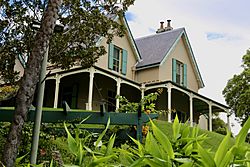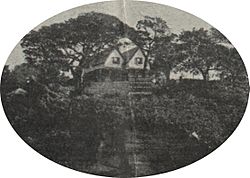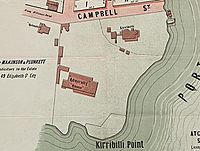Kirribilli House facts for kids
Quick facts for kids Kirribilli House |
|
|---|---|

Kirribilli House, pictured in 2019
|
|
| General information | |
| Architectural style | Cottage ornée |
| Address | 109 Kirribilli Avenue, Kirribilli, New South Wales |
| Country | Australia |
| Coordinates | 33°51′05″S 151°13′09″E / 33.851286°S 151.21915°E |
| Current tenants | Not occupied |
| Completed | 1855 |
| Design and construction | |
| Architect | Adolphus Frederic Feez |
| Official name | Kirribilli House; Kirribilli House Garden & Grounds |
| Type | Historic |
| Criteria | a., b., d., e., g., h. |
| Designated | 22 June 2004 |
| Reference no. | 105451 & 105589 |
Kirribilli House is one of two official homes for the Prime Minister of Australia. It is located in Sydney, New South Wales, right by the harbour in a suburb called Kirribilli. The other official home for the Prime Minister is The Lodge in Canberra.
Even though Kirribilli House was meant to be a second home, some Prime Ministers, like John Howard, Tony Abbott, and Scott Morrison, have used it as their main home. The house, its gardens, and the land around it are important and are listed on the Commonwealth Heritage List.
Contents
Discover Kirribilli House
In 1854, a merchant named Adolphus Frederic Feez bought a piece of land in Kirribilli for £200. This land was once part of the property next door, called Wotonga House (which is now part of Admiralty House).
Feez built a beautiful house in a style called "Gothic-style" or "cottage ornée" on the highest part of the land. This means it looked like a fancy, decorated cottage with pointed roofs, detailed wooden patterns, and bay windows. The house was finished in 1855.
Over the years, many different people owned Kirribilli House. In 1919, Arthur Wigram Allen bought it for £10,000. He wanted to divide the land into smaller blocks to sell. However, people were upset about this plan. So, in 1920, the Prime Minister at the time, Billy Hughes, decided the government should buy the property.
A Home for Leaders
After the government bought it, Kirribilli House was first used by the staff of the Governor-General of Australia. The Governor-General lives next door at Admiralty House. From 1930, the house was rented out to different people.
Then, in 1956, Kirribilli House was officially set aside for Australia's Prime Ministers. It is used when they need to work or host important guests in Sydney. It's a place for official events and hospitality.
Kirribilli House is on the North Shore of Sydney Harbour. It has amazing views of the Sydney Harbour Bridge, Circular Quay, and the Sydney Opera House. Many important people from around the world have visited this house.
You can sometimes visit Kirribilli House! It is open to the public on one special day each year, thanks to The Australiana Fund.
History of Kirribilli House
The First Owner: Adolphus Frederic Feez
Adolphus Frederic Feez, who built Kirribilli House in 1855, was born in Germany in 1826. He first went to London in 1849, where he was known as a merchant and an architect. In 1851, he moved to Sydney.
He became a successful merchant and was a partner in a trading company called Rabone, Feez and Co. His brother, Albrecht Feez, later became a well-known person in Rockhampton.
Feez lived in Kirribilli House for several years. He called it "Sophienberg." Later, he moved to Balmain. He married Frederica and they had two children while living in Sydney. Sadly, he died in 1869 at only 43 years old during a business trip to Fiji. Frederica and her children then moved back to Germany.
The Lawry Family's Time
Around 1858, Thomas and Esther Lawry became the next people to live in Kirribilli House. Thomas Lawry worked for the Ordnance Department in Sydney for his whole life. He was also made a magistrate by the Governor. He married Esther Hughes in 1858, and they had two children. In 1859, a newspaper reported the birth of their daughter at "Sophienberg," so the house kept its original name for a while.
Esther Lawry inherited a lot of money from her grandmother, Rosetta Terry. Rosetta was the step-granddaughter of Samuel Terry, a very rich former convict who became a successful businessman.
In 1865, Thomas Lawry died at 44. His death notice still called the house "Sophienberg." Two years later, in 1867, Esther married James Taylor. He was in charge of supplies for the military. Esther, her two children, and James lived in the house. One of her children was Thomas Terry Trewyn Lawry.
By 1891, when James Taylor died, the house had been renamed "Kirribilli." It was located on Campbell Street, as shown on the map. Esther died in 1900, and the house was left to her son, Thomas Terry Trewyn Lawry.
Thomas Terry Trewyn Lawry was born in 1864. He had poor health and never married. In 1907, he died at only 42 years old from heart failure. Since he had no children, he left his property to relatives and others. His will was very complicated. He left Kirribilli House to several people, including Laura Lamotte.
Laura married William Donald McCrea in 1909. Laura and William lived in the house for some time, but Laura wanted to sell it. There was a disagreement with the other people who were supposed to inherit parts of the property, so the matter went to court. The court decided the property should be sold, and it was put up for sale in 1919.
Arthur Wigram Allen bought the house, planning to divide the land. In 1920, he made a brochure with a picture of the house and his plans for dividing the land.
However, there was a big public protest about the sale. The government, led by Prime Minister Billy Hughes, decided to buy the house back. Kirribilli House has been owned by the government ever since.
Images for kids
-
Kirribilli House and Admiralty House in 1930. You can see the Sydney Harbour Bridge being built in the background.





